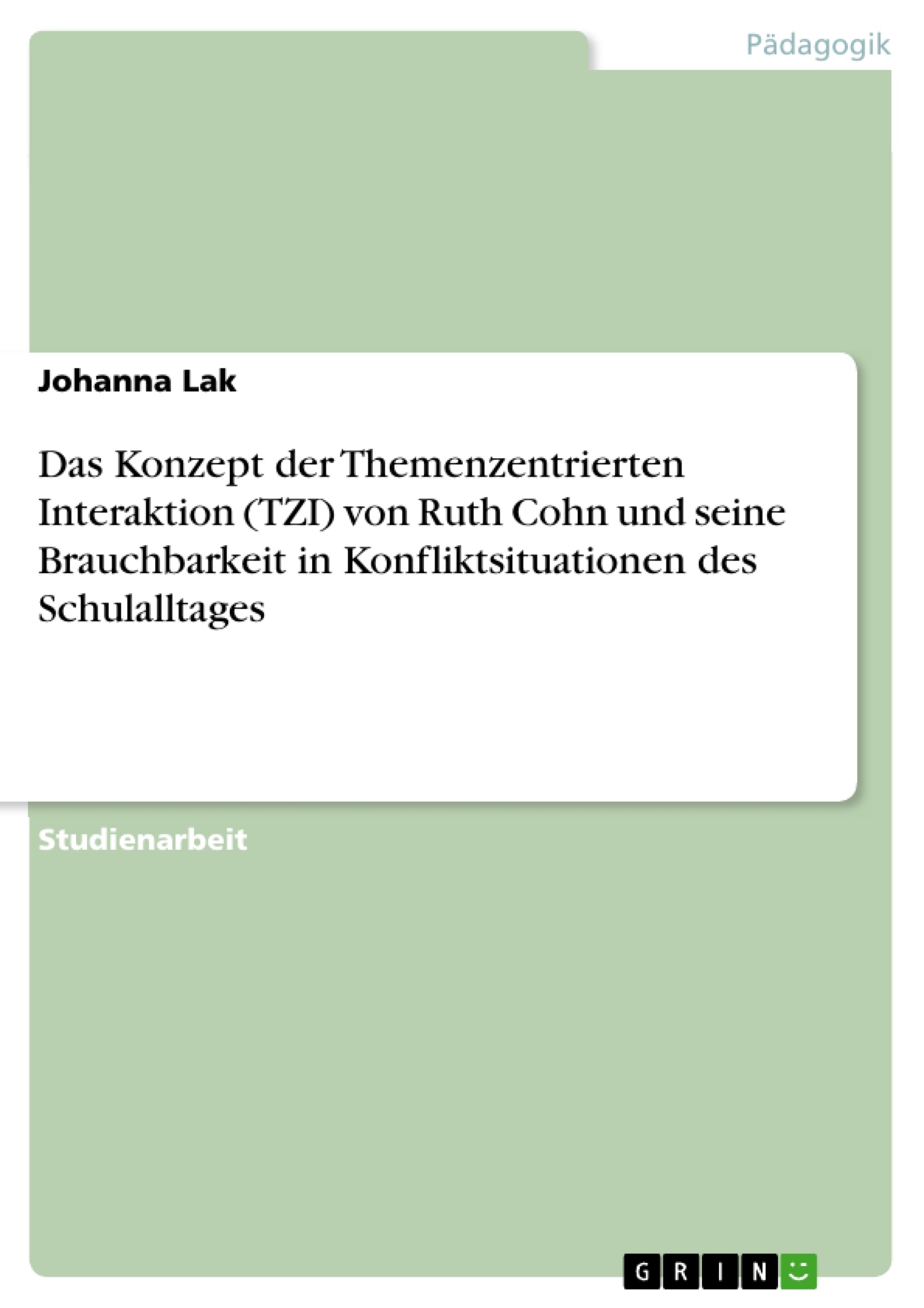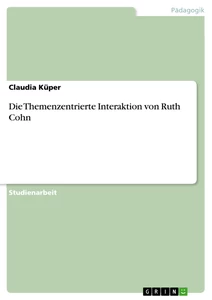Themenzentrierte Interaktion Ruth Cohn Pdf
Introduction1 What is a group?2 Group Dynamics – Theme-Centered Interaction3 Developing Into a Group – Group Phases According to Tuckman3.1 Forming - The Foundation Phase3.2 Storming - Conflict over Different Objectives3.3 Norming - Decision and Compromise3.4 Performing – The Work Phase4 Theory in Practice4.1 Forming4.2 Storming4.3 Norming4.4 Performing4.5 Re-FormingSummaryAnnex IntroductionIn the course of my academic studies, respectively my professional career, I have frequently worked with groups in the field of youth and adult education. Some of the projects, however, were striking in the sense that groups in various contexts would rather function according to a certain “gut feeling” instead of a guiding concept. In the light of this background the nature and functioning of groups as well as attention towards the role of the group leader as a moderator gain topicality for a social-pedagogical practice in the area of social communication.Therefore, I would like to analyze the functioning of groups and their development processes in the present work. To this end, I would like to ask questions like: What are their guiding principles? Which models describe functions and processes of groups? And in this context: What are the tasks that group leaders encounter?Since the literature covering the topic of group work and associated models takes on an almost unmanageable dimension, I will narrow my description of the theoretical framework to the model of Theme-Centered Interaction by Ruth Cohn on one hand, for it conveys a specific holistic feel for the inner workings of the group. On the other hand, I rely on the model of group phases by Tuckman, who in my opinion has described the essentials of group development in a model of developmental phases.
From my point of view, both models represent in elementary ways the basics and initial tool chest for working with groups in education. Furthermore, it is the objective of this work to complement the theoretical statements with practical descriptions and solutions. With regard to this, I can already look back on numerous experiences in my own group work. In the final part of this report, I would like to introduce cooperation and trust games that can have positive effects on the respective group situations.
1 What is a group?The social sciences offer a broad variety of definitions for the term ‘group’. In an effort to generalize, it could be postulated that a group consists of a number of persons that over a certain time span and through relatively regular and close relationships engage in a reciprocal interaction with each other (see Metzinger 1999, p. Several characteristics allow for a more detailed description of the group as follows:Feeling of togetherness (sense of unity), permanence (temporarily or continuously), interaction and communication, group goals, norms and values, and distinct group functions.Furthermore, groups can be classified according to type and size.
Since the herein presented work is focusing on the group setting of a seminar or workshop session, the group definition aligns more with that of a large group; and has to be considered a secondary group – meaning, it is characterized by its orientation towards a goal and purpose; it is deliberately managed and thus it has to be seen as a formal group. It has to be considered an in-group because – although within a limited time - social relationships, familiarity, sense of unity, sympathy and cooperation are unifying elements (see Metzinger 1999, p.


2 Group Dynamics – Theme-Centered InteractionTheme-Centered Interaction (TCI) is a method developed by Ruth Cohn starting in the 1950s. For Cohn, the central question giving the impulse for the development of TCI, was how the character-strengthening factors of therapeutic working methods could be put to use for learning and working in non-therapeutic groups and in daily life. TCI always finds fertile ground for an application when a process is supposed to develop that is personal and at the same time refers to other contents and to the environment. Among other things, it is used in outdoor trainings, in psychological counseling and therapy, in the socio-educational context, or in youth and adult education (see Langmaack/Braue-Krickau 2000, p. 88 f.).TCI considers itself embedded in the traditions of humanistic psychology and sees the human being in a holistic view, characterized by its dimensions head, heart, and hand. This humanistic attitude of TCI particularly translates to the so-called axioms that can be understood as the ethical foundation of the method.
Themenzentrierte Interaktion Ruth Cohn Pdf File
They reflect TCI’s conception of the world and of human existence (see Galuske 2001, p.254). And so Ruth Cohn describes three fundamental axioms:Holistic Nature of the Conception of ManThe human being is a psycho-biological unit, and therefore autonomous and interdependent. Autonomy (self-reliance) grows with the cognizance of interdependence (interconnectedness).Humanity and Protecting the CreationAll life and its thriving deserves reverence.Freedom and ResponsibilityFree decision-making happens within inner and outer boundaries, which can be expanded (see Cohn 1975, p.120).The axioms present the cognitive basis of TCIs, playing a fundamental role in how decisions are made that hold up humans themselves and a sustainably viable social, economical, and ecological environment as standards (see Langmaak/Braue-Krickau 2000, p. 94f.).Cohn managed to translate the holistic perspective of TCI with clear variables for working with groups: “Each group interaction contains three factors that could be described as the apexes of a triangle: 1. The I, the personality; 2.
The We, the group; 3. The It, the topic. This triangle is encased in a sphere (globe) representing the environment in which the interactional group is meeting.
This environment is defined by time, location, and their historic, social, and teleological circumstances” (Cohn 1975, p. 113 f.).This concept is visualized with the following schematic:Abbildung in dieser Leseprobe nicht enthaltenSource: URL: accessed on The apexes of the triangle are interrelated. The task of the group management consists in finding a state of dynamic balance for these apexes.
The perpetual process should always re-examine what the individual persons need in the moment (I-level), in order for the group (We-level) to become or remain fit to work and learn, and to advance the cause (Topics-level) that motivates them and that they want to implement in their everyday lives (Globe-level).For the practical use of TCI, two postulates have become increasingly important and should be regarded as rules of communication:Be your own chairman!“Listen to your inner voices – your distinct needs, wishes, motivations, and ideas. Use all of your senses - hear, see, smell, and perceive. Use your spirit, your knowledge, your power of judgment, your responsibility, and your brainpower. Weigh decisions carefully. Nobody can make your decisions for you and nobody can cover the costs that arise for you from those decisions.

You are the most important person in your world, like I am in mine. We have to be able to articulate clearly and to listen carefully, because this is our only bridge from island to island” (Langmaack 2000, p. 74).Disruptions have priority!When working on a topic, it is imperative to treat disruptions occurring in the interaction context with priority, as disruptions are an indication for group-specific but also individual problems. Only if disruptions are perceived and taken seriously as hints of this kind, they can be identified in the group process (see Galuske 2001, p. 3 Developing Into a Group – Group Phases According to TuckmanHow does the group process unfold precisely? In order to answer this question, I refer to a model that seeks to simplify the complexity of group dynamics to the point where tangible recommendations for team development can be derived. Excerpt out of 15 pagesDetails Title What is a group and how does a group function?
Group dynamics and the model according to Bruce Tuckman and Ruth Cohn College Grade 1,3 Author Year 2011 Pages 15 Catalog Number V351141 ISBN (eBook) 622 ISBN (Book) 639 File size 1027 KB Language English Tagswhat,group,dynamics,bruce,tuckman,ruth,cohnPrice (Book)13.99 €Price (eBook)12.99 € Quote paper, 2011, What is a group and how does a group function? Group dynamics and the model according to Bruce Tuckman and Ruth Cohn, Munich, GRIN Verlag, comments yet.